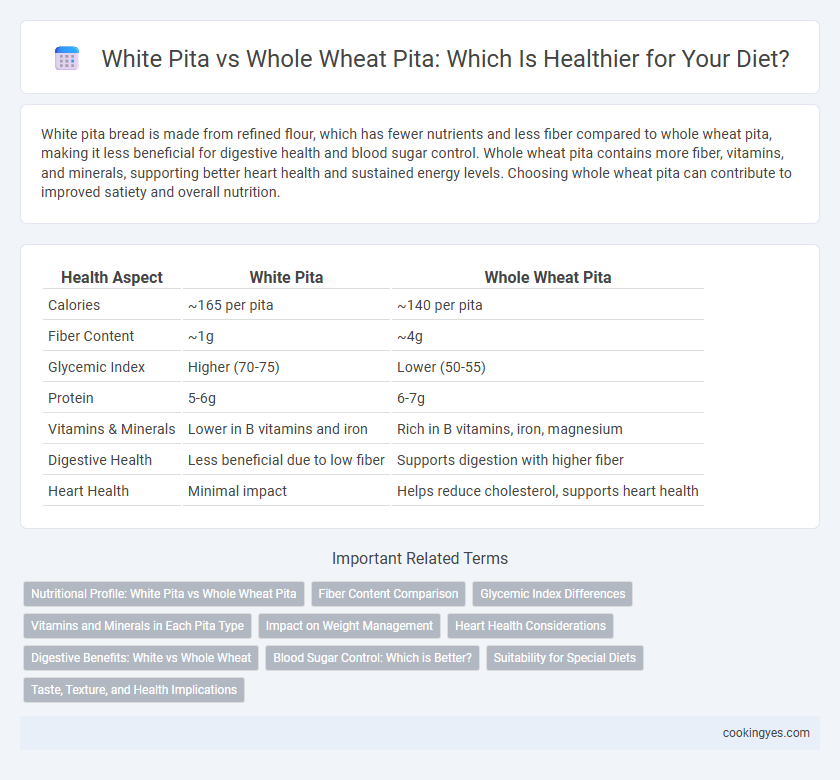White pita bread is made from refined flour, which has fewer nutrients and less fiber compared to whole wheat pita, making it less beneficial for digestive health and blood sugar control. Whole wheat pita contains more fiber, vitamins, and minerals, supporting better heart health and sustained energy levels. Choosing whole wheat pita can contribute to improved satiety and overall nutrition.
Table of Comparison
| Health Aspect | White Pita | Whole Wheat Pita |
|---|---|---|
| Calories | ~165 per pita | ~140 per pita |
| Fiber Content | ~1g | ~4g |
| Glycemic Index | Higher (70-75) | Lower (50-55) |
| Protein | 5-6g | 6-7g |
| Vitamins & Minerals | Lower in B vitamins and iron | Rich in B vitamins, iron, magnesium |
| Digestive Health | Less beneficial due to low fiber | Supports digestion with higher fiber |
| Heart Health | Minimal impact | Helps reduce cholesterol, supports heart health |
Nutritional Profile: White Pita vs Whole Wheat Pita
Whole wheat pita offers higher fiber content and more essential nutrients like magnesium, zinc, and iron compared to white pita, aiding digestion and supporting overall health. White pita typically contains fewer calories and less fiber but may have a softer texture preferred by some consumers. Choosing whole wheat pita enhances daily intake of complex carbohydrates and antioxidants, which contribute to better heart health and sustained energy levels.
Fiber Content Comparison
Whole wheat pita contains significantly higher dietary fiber than white pita, with approximately 5 grams of fiber per serving compared to 1 gram in white pita. This increased fiber content in whole wheat pita aids digestion, promotes satiety, and supports heart health by helping to regulate blood cholesterol levels. Choosing whole wheat pita enhances daily fiber intake, contributing to better overall digestive health and optimal nutrient absorption.
Glycemic Index Differences
White pita typically has a higher glycemic index (GI) than whole wheat pita, causing a quicker spike in blood sugar levels after consumption. Whole wheat pita contains more fiber and complex carbohydrates, which slow digestion and result in a lower GI, promoting better blood sugar control. Choosing whole wheat pita supports improved insulin sensitivity and sustained energy release, making it a healthier option for managing glucose levels.
Vitamins and Minerals in Each Pita Type
White pita typically contains fewer vitamins and minerals compared to whole wheat pita, as it is made from refined flour that has lost much of its nutrient-rich bran and germ. Whole wheat pita offers higher levels of essential nutrients like vitamin B6, magnesium, zinc, and iron due to the preservation of the whole grain components. Choosing whole wheat pita supports better intake of dietary fiber and micronutrients crucial for metabolism and immune function.
Impact on Weight Management
Whole wheat pita contains higher fiber content compared to white pita, promoting satiety and aiding in weight management by reducing overall calorie intake. The lower glycemic index of whole wheat pita helps stabilize blood sugar levels, preventing rapid spikes and crashes that can lead to overeating. Choosing whole wheat pita over white pita supports better digestion and metabolic health, key factors in effective weight control.
Heart Health Considerations
Whole wheat pita contains higher fiber content and essential nutrients like magnesium and antioxidants, which contribute to improved heart health by helping to lower cholesterol levels and reduce inflammation. White pita, made from refined flour, lacks these vital components and may cause quicker spikes in blood sugar, negatively affecting cardiovascular risk factors. Choosing whole wheat pita supports better heart health through sustained energy release and enhanced nutrient intake.
Digestive Benefits: White vs Whole Wheat
Whole wheat pita offers superior digestive benefits compared to white pita due to its higher dietary fiber content, which promotes regular bowel movements and supports gut health. The bran and germ in whole wheat help increase stool bulk and feed beneficial gut bacteria, enhancing digestion and nutrient absorption. White pita, lacking these components, provides fewer fibers and may lead to slower digestion and less satiety.
Blood Sugar Control: Which is Better?
Whole wheat pita contains higher fiber content than white pita, aiding in slower glucose absorption and better blood sugar control. The complex carbohydrates in whole wheat pita contribute to a lower glycemic index, making it a preferable option for managing blood sugar levels. White pita, made from refined flour, causes quicker spikes in blood glucose, which may be less ideal for individuals with insulin resistance or diabetes.
Suitability for Special Diets
White pita typically contains refined flour, which lacks fiber and essential nutrients, making it less suitable for high-fiber or diabetic diets. Whole wheat pita, rich in fiber, vitamins, and minerals, supports digestive health and better blood sugar control, ideal for those managing diabetes or seeking heart-healthy options. Gluten-free diets require alternative pitas made from non-wheat flours, as both white and whole wheat pitas contain gluten.
Taste, Texture, and Health Implications
White pita offers a soft texture and mild flavor, making it a versatile choice for various fillings, while whole wheat pita provides a denser texture with a nuttier taste due to its higher fiber content. Nutritionally, whole wheat pita contains more vitamins, minerals, and antioxidants, contributing to better digestion and sustained energy release compared to the more refined white pita. Health benefits of whole wheat pita include improved heart health and blood sugar control, making it a preferred option for those seeking a nutrient-rich bread alternative.
White Pita vs Whole Wheat Pita for Health Benefits Infographic

 cookingyes.com
cookingyes.com